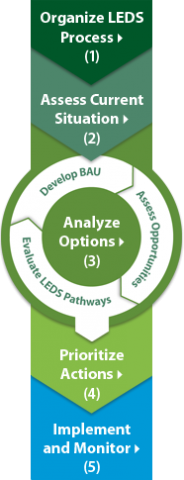Emission factors are coefficients that quantify the greenhouse gas (GHG) emissions or removals...
Low Emission Development Strategies (LEDS)
 A low emission development strategy is the foundation for climate-smart, transformative development. The USAID LEAD program works with Asian governments, businesses, and others to prepare and implement LEDS. The program provides analytical tools, models, training, demonstration projects, and scientific support for effective, low-emissions strategies at the regional, national, and local levels.
A low emission development strategy is the foundation for climate-smart, transformative development. The USAID LEAD program works with Asian governments, businesses, and others to prepare and implement LEDS. The program provides analytical tools, models, training, demonstration projects, and scientific support for effective, low-emissions strategies at the regional, national, and local levels.
What is a LEDS?
A LEDS is a country-led and country-specific national strategic analysis and planning process covering all economic sectors for promoting economic growth while reducing long-term GHG emission trajectories. At a practical level, a LEDS is the strategic framework, based on sound analytical foundations, that articulates concrete actions, policies, programs, and implementation plans to promote economic growth over the long term in a way that lowers a country's GHG emissions from what they would be if the country carried on with business as usual. LEDS are voluntary and non-binding. Because each country has unique national circumstances and priorities, each country develops and drives its own LEDS strategy.
What is Enhancing Capacity for Low Emission Development Strategies (EC-LEDS)?
The USAID LEAD program supports and complements the US Government's Enhancing Capacity for Low Emission Development Strategies (EC-LEDS) initiative. EC-LEDS supports developing countries’ efforts to pursue long-term, transformative development and accelerate sustainable, climate-resilient economic growth while slowing the growth of greenhouse gas emissions. The program is an integral part of U.S. Government efforts to provide fast start climate financing and will build capacities in partner countries, provide targeted technical assistance, and build a shared global knowledge base on low emission development. EC-LEDS supports and enhances country-led development programs, plans, and policies, and complements efforts of other international donors and organizations to support low emission development strategies (LEDS).
EC-LEDS country partners in Asia include Bangladesh, Cambodia, Indonesia, Kazakhstan, the Philippines, Thailand, and Vietnam.
For more information about the EC-LEDS initiative, click here.
Technical Assistance and Training
The USAID LEAD program provides analytical tools, models, training, and demonstration projects for low emission strategies at the regional, national, and local levels. For example, LEAD helps countries develop GHG emissions projections under varying policy scenarios. This enables countries to assess the costs, benefits, and impact of different development paths.
Economic and Emissions Analysis and Modeling Support
The USAID LEAD program works to enhance developing countries’ capacity to conduct economic and GHG emission analyses to support improved planning for sustainable low-carbon economic growth. LEAD supports training and technical assistance to enhance analytical capacity in support of LEDS, such as economic and emissions modeling, technology pathways, marginal abatement cost (MAC) curve development. Examples of models and analytical tools for which the LEAD program can provide capacity building and support include:
- The Long range Energy Alternatives Planning System (LEAP) model developed by the Stockholm Environment Institute (SEI), a LEAD implementing partner. LEAP is used for medium- to long-term energy planning and GHG mitigation assessment. It can track energy consumption, production, and resource extraction in all sectors of an economy, and can account for both GHG emission sources and sinks in the energy and non-energy sectors.
- Marginal abatement cost (MAC) curves. MAC curves are sets of options to reduce GHG emissions or other pollutants. A marginal abatement cost curve states the specific costs of mitigation of the different options. It presents how much tCO2 emissions can be abated per specific option and thereby the amount of money it will cost or save per tCO2.
- Natural resource valuation techniques to support land use allocation decision processes. These techniques can improve cost-benefit analysis to inform land managers on the ecological, economic, and social implications of different, potentially competing, land use options. The LEAD program collaborates and coordinates with the USAID/RDMA Lowering Emissions in Asia's Forests (LEAF) program and other partners in building this capacity within the region.
Related Links
- USAID's Climate Change and Development Strategy
- LEDS: Technical, Institutional and Policy Lessons (OCED report, 2010)
- The Asia LEDS Partnership
- The LEDS Global Partnership
- LEDS Toolkit on the Open Energy Information (Open EI) website
- Green Growth in Asia and the Pacific (UNESCAP and partners)
- Review of Networks and Platforms for Low Emission and Climate Compatible Development Planning (report by the Coordinated Low Emissions Assistance Network (CLEAN), 2011)
- EC-LEDS Fact Sheet: U.S. Government Supports Low emission economic growth
- EC-LEDS Fact Sheet: Advancing Low Emission Growth in the Philippines
- EC-LEDS Fact Sheet: Climate Resilient Low Emission Development in Bangladesh







